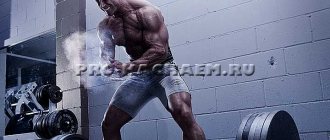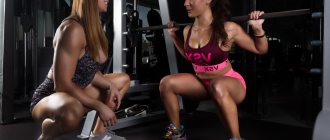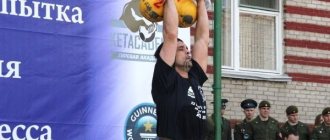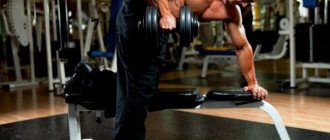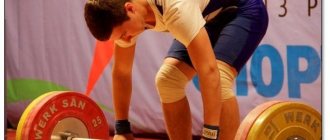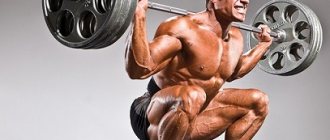What is a kettlebell?[edit | edit code]
Kettlebells 8, 12, 16, 24 and 32 kg
| Emblem of the Kettlebell Lifting Federation |
| Weight-lifting |
|
| Theory |
|
| Inventory |
| Training |
|
| Competitive exercises |
|
| Preparatory exercises |
|
| Nutrition and recovery |
|
Weight
- a sports equipment of a given mass, which has a special shape in the form of a metal core with a handle and other design features.
The word kettlebell first appeared in the Russian dictionary in 1704 (Cherkikh, 1994).
Artistic weights, with faces
Weights by weight[edit | edit code]
Russian weights are traditionally measured in pounds. One pud is an old Russian unit of measurement equivalent to 16 kilograms (about 35 pounds). The most popular weights in Russia: 1 pound for beginner men; 1.5 pounds, or 53 pounds - the standard weight of an army weight; and the so-called “dvuhpudovka”, 2 poods, or 70 pounds. The two-pudovka is used by experienced weight lifters.
Competitions in kettlebell lifting are held with kettlebells weighing 16, 24 and 32 kg. During training, weights of a more varied gradation are used.
According to the rules of the MSGS, MFGS, VFGS, sports competitive weights must have the following parameters:
| Dimensions | Color |
| height - 280 mm | 16 kg - yellow |
| case diameter - 210mm | 24 kg - green |
| handle diameter - 35 mm | 32 kg - red |
Approximate conversion of poods and kilograms to pounds
| Puds | Kilograms | Pounds | |
| 0,25 | 4 | 9 | |
| 0,375 | 6 | 13 | |
| 0,5 | 8 | 18 | |
| 0,75 | 12 | 26 | |
| 1 | 16 | 35 | For beginners |
| 1,25 | 20 | 44 | |
| 1,5 | 24 | 53 | Popular army option |
| 1,75 | 28 | 62 | |
| 2 | 32 | 70 | For experienced weightlifters |
| 2,5 | 40 | 88 | |
| 3 | 48 | 106 |
Heavy kettlebells are traditionally called "bulldogs"
. “Heavy” is a relative concept; usually weights heavier than 32 kg are included in this category. 48 kg is the maximum weight for a kettlebell, but it did not stop Russian strongmen. Weightlifting legend Yuri Vlasov was upset when someone stole his custom-made 56kg weights.
Dragon Door produces high-quality classic Russian-style rubber-coated cast iron kettlebells ranging from 26 to 106 pounds and women's kettlebells from 9 to 18 pounds.
Kettlebell training[edit | edit code]
Kettlebells provide complete and comprehensive development. Multifunctional strength, power and flexibility. They get rid of fat without necessarily doing aerobics. In just 1-2 hours of training per week. All you need is one compact and literally indestructible projectile that can be used anywhere.
What kind of weights do you need?[edit | edit code]
Start with one weight, the table will help you choose the right weight. If funds allow, buy a set of three or four weights presented in the table.
| Start with the right kettlebell | ||
| Who are you? | Kettlebell to start (kg) | Ideal set (kg) |
| Average girl | 8 | 8, 12, 16 |
| Strong girl | 12 | 12, 16, 20 |
| Average man | 16 | 16, 20, 24, 32 |
| Strong enough man | 20 | 20, 24, 32 |
| Very strong man | 24 | 24, 32, 40 |
Do you need two kettlebells of the same weight? Not yet. There are great double kettlebell exercises, watch senior kettlebell trainer Mike Mahler do them, but they're not for beginners. Start with one kettlebell, work on strength imbalances, and train the snatch and press.
The average person should start with a 16kg kettlebell. What does "average" mean? If the bench press is used as a standard test to evaluate strength (which is incorrect), then a man lying on a bench pressing a barbell weighing 90 kg should start with 16 kg. If you bench more than 90 kg, then try training with a 20 kg kettlebell. If you are a powerlifter or strongman, start with 24 kg.
A woman with average physical fitness should start with 8 kg. A strong woman can try 12 kg. Most women should aim for 16kg. Few stubborn women will go further. Katherine "Catherine of Steel" Imes, a master kettlebell lifter, can bench press a 32kg kettlebell five times, putting many men to shame.
You've probably noticed that the weight of kettlebells, unlike dumbbells, increases in larger increments. There is simply no need for additional hardware. Inventive weightlifters don't need a ton of weights to progress their workouts. You save money and space.
https://youtu.be/yulAKyL_RgI
Training complexes
For the kettlebell, just like for other equipment, special schemes have been developed that allow you to pump almost all the necessary zones. Conventionally, they can be divided into complexes for beginners and advanced athletes.
For beginners
Beginners should start with the “base”. Many of the nuances of the technique for performing it intersect with elements where dumbbells are used as equipment:
- Deadlift.
Technique:
- place your feet shoulder-width apart with your toes turned out;
- bending your knees slightly, move your pelvis back, bend over and take the weight with both hands;
- the back is straight, the shoulders are above the knee joints;
- gradually straightening up, smoothly lift the projectile;
- descending, return to IP.
Technique:
- IP, as with deadlift;
- bring the weight back behind your feet;
- make a swing, bringing your arms to a position parallel to the floor;
- straighten up at the top point and return to IP.
You should not develop a strong amplitude, as this will reduce the load on your back.
- Snatch with a push.
Technique:
- place the projectile at a distance of 20 cm from the toes;
- hold the weight by the heels (as on swings);
- start the swing, performing a “detonation” at waist level (sharply pull your arm towards you, throwing the projectile over your shoulder);
- extend your arm with the weight up without bending your elbow;
- carefully and smoothly return to the IP.
The push is carried out while exhaling, lowering - while inhaling.
- Squats.
Technique:
- pull the weight towards you, focusing on your chest;
- place your feet wider than your shoulders, toes slightly apart;
- start squatting until your thighs reach parallel to the floor (don’t lift your heels);
- smoothly return to IP.
Don't round your back or lean forward too much.
| Name | What muscles are loaded? | Sets | Replays |
| Deadlift with kettlebell | Buttocks, thighs | 2-3 | 6-8 |
| Mahi | External thigh, gluteal, back | 2-3 | 6-8 |
| Snatch and jerk | Biceps, triceps, shoulders | 2-3 | 6-8 |
| Squats with a projectile | Hamstrings, glutes, calves | 2-3 | 6-8 |
For experienced
Advanced athletes maintain the basics by complicating it and increasing the weights:
- Kettlebell push-ups.
Simple option:
- the projectile is placed bottom on the floor, hands rest on the handle, after which classic push-ups are performed.
Complicated version:
- the weight is placed on the handle, the hands rest on the bottom, and push-ups are carried out in the mode of maintaining the overall balance of the body.
- Bulgarian squat with apparatus.
Technique:
- stand up straight, placing one foot with your toe on the bench behind your back;
- pull the projectile towards your chest;
- slowly squat until your bent knee touches the floor;
- rise smoothly, returning to the IP.
The exercise is performed with each leg alternately.
Benefits of training with kettlebells[edit | edit code]
- the weight of each weight falls on only one support point, due to which the ligaments and small muscles work at full strength, stabilizing the load. The weights are designed in such a way that the weight is distributed across two support points at once. This greatly facilitates the work of the stabilizers and makes it more balanced. They do not limit the strength of the working muscle, which allows the athlete to cope with a greater load;
- Weight gain has a greater impact on these same stabilizers, causing them to become stronger. This allows you to periodically increase weight, which leads to further increases in strength and muscle mass;
- kettlebell training is almost not dangerous, the likelihood of injury is minimized;
- kettlebells do not require strict exercise techniques. These implements are pulled or pressed in a way that is convenient; the athlete’s body optimally distributes the load between the working muscles. This promotes rapid weight gain;
- distributing the load across a large number of muscle groups leads to maximum intensity of exercise, which gives the athlete several more advantages: the hormonal surge occurs more intensely, so metabolic reactions accelerate tens of times, which not only helps to build the athlete’s muscle mass, but also increases his strength (damaged cells replaced with ones more adapted to the load). Subcutaneous fat is also burned more intensely;
- over a certain period of time, a larger amount of blood passes through the target muscle, bringing much more nutrients and hormones to the cells than during regular training. Thus, an ideal environment arises for the development of both muscles and other parts of the musculoskeletal system;
- Kettlebells are always lifted in the same way as any large weight would be lifted in natural conditions.
To summarize, we can conclude that kettlebell training is the best for developing functional strength. As a result of such training, the athlete will move easier, react faster and (if necessary) hit harder.
Main conclusions
The kettlebell is an excellent apparatus that allows you to pump up most muscles during the execution of one complex:
- In addition to muscles, the kettlebell develops joints, ligaments, and stabilizers responsible for maintaining posture.
- Training with this equipment includes both cardio and strength training, so there is no need for additional elements.
- Like any exercise, working with a kettlebell requires a preliminary warm-up to warm up the muscles and strengthen the joints.
- This equipment can be used for both high-intensity training (HIIT) and CrossFit.
- Exercises with kettlebells contribute to weight loss, as they are energy-consuming, but have little effect on the growth of muscle tissue.
- Complexes with this projectile develop explosive strength and endurance.
- Correct execution technique directly affects the results.
The kettlebell is very dangerous if you don’t know and can’t handle it. This point should be taken into account both when selecting equipment and when drawing up a training program.
Structure of the kettlebell[edit | edit code]
Structure of a kettlebell Structure of a kettlebell
Example of the structure of a kettlebell on RF patent No. 2484870:
contains a spherical balanced hollow body (1) with a cut (2) at the bottom, a bow (3) at the top and weights (6) with threaded fixation inside the cavity, the cavity of the spherical body is open from the side of the lower cut (2), made cylindrical, vertical from the inside thread (4). In its middle and upper part, the cylindrical cavity has lateral symmetrical relief recesses (8). The weights (6) are made disc-shaped with an external thread corresponding to the internal thread (4) of the cylindrical cavity; at the ends of the weights 6 they have recesses (9) for their installation. On the cut side (2), the cylindrical cavity is closed with a removable plug (5). The end recesses (9) of the weights (6) can be made for installation with your fingers. The removable plug (5) can be equipped with holes (10) for installation with your fingers. The body (1) of the weight contains two horizontal, diametrical, parallel to the horizontal section of the arch, holes (7) for visual monitoring of the position of one or two weights (6), respectively. The technical result is the implementation of a sports apparatus with a stepwise variable weight, for training with a gradual increase in load, while maintaining the outer surface of a standard competitive weight and its balance (at the center of mass), as well as improving the fixation of loads inside the cavity.
https://youtu.be/8UVQZS_jPA8
How to make a kettlebell. DIY gym
Tumbler weight (device)[edit | edit code]
The Tumbler is good because it always stands on its base. That is, its internal content does not allow it to fall and return to its original position from any position.
History of kettlebell lifting
— In weightlifting, an athlete strives to lift the maximum weight;
— In kettlebell lifting, the standard is not the weight of the apparatus, but the number of repetitions of the exercise performed.
In other words, if weightlifting is strength training in its pure form, then kettlebell lifting can be freely classified as a mixed, aerobic and anaerobic form of cardio training type.
Delivery in the Leningrad region
The cost of delivery within the Leningrad region depends on the cost of the order, as well as the dimensions of the goods.
| City | up to 7000r | 7000-10000 | 10000-15000 | 15000-20000 | more than 20000 |
| Bugry village | 400 | for free | |||
| Vsevolozhsk village | 700 | 400 | for free | ||
| Vyborg | 2600 | 2300 | 1950 | 1800 | 1400 |
| Gatchina | 1160 | 860 | 510 | 360 | for free |
| Zelenogorsk | 900 | 600 | 250 | 100 | for free |
| Kingisepp village | 2800 | 2500 | 2150 | 2000 | 1600 |
| Kirishi village | 3600 | 3300 | 2950 | 2800 | 2400 |
| Kirovsk | 1220 | 920 | 570 | 420 | for free |
| Kolpino | 880 | 580 | 230 | for free | |
| Koltushi village | 620 | 320 | for free | ||
| Kommunar | 1040 | 740 | 390 | 240 | for free |
| Krasnoe Selo | 780 | 480 | 130 | for free | |
| Kronstadt | 760 | 460 | 110 | for free | |
| Kudrovo | 400 | for free | |||
| Lomonosov | 1000 | 700 | 350 | 200 | for free |
| p. Metallostroy | 660 | 360 | for free | ||
| p. Murino | 400 | for free | |||
| Novoye Devyatkino village | 400 | for free | |||
| Novoe Okhta village | 400 | for free | |||
| New Okkervil | 400 | for free | |||
| Pavlovsk | 880 | 580 | 230 | for free | |
| Pargolovo village | 400 | for free | |||
| Peterhof | 1020 | 720 | 370 | 220 | for free |
| Petro-Slavyanka village | 720 | 420 | for free | ||
| Pushkin | 780 | 480 | 130 | for free | |
| Sergievskoe municipal district (Parnas municipal district) | 380 | for free | |||
| Sertolovo | 580 | 280 | for free | ||
| Sestroretsk | 620 | 120 | for free | ||
| Sosnovy Bor | 1660 | 1360 | 1010 | 860 | 460 |
| Strelna | 800 | 500 | 150 | for free | |
| p. Tosno | 1380 | 1080 | 730 | 580 | 180 |
| Shlisselburg | 1220 | 920 | 570 | 420 | for free |
| Shushary village | 400 | for free | |||
| village Yanino | 500 | 200 | for free | ||
The cost is indicated for delivery to the entrance of non-large goods. In case of delivery of large goods, as well as goods weighing 50 kg or more, to the entrance, the delivery cost increases by 250 rubles.
The cost of delivering goods to your doorstep in the Leningrad region to cities not listed above is calculated by the online store manager and depends on the order amount.
If the courier brought you a product of proper quality, but you did not like/do not like the product for any reason (color, size, etc.), then you pay courier services in the amount of 100%.
Precautionary measures
The short cycle push is considered a safe exercise, however, if the technique of performing the kettlebell push is violated, you can easily get a lower back injury. There are several points to pay attention to.
Do not pick up heavier weights until you have been able to short-cycle the current apparatus at least 80 times. Why exactly 80? All due to the inability to scale loads in small steps. The difference in the weights of the equipment is half a pound (8 kg), and if you have not sufficiently prepared your body for the increase in load, you can temporarily replace the weights with dumbbells of intermediate weights (18-20 kg if you worked with pound weights).
The second danger is incorrect squatting technique. Very often, athletes round their back, which creates additional stress on the spine and can lead to microdislocation of the lumbar region. For the same reason, lifting the weights to the starting position is carried out with an arched back.
https://youtu.be/fl3HtxUqaXs
